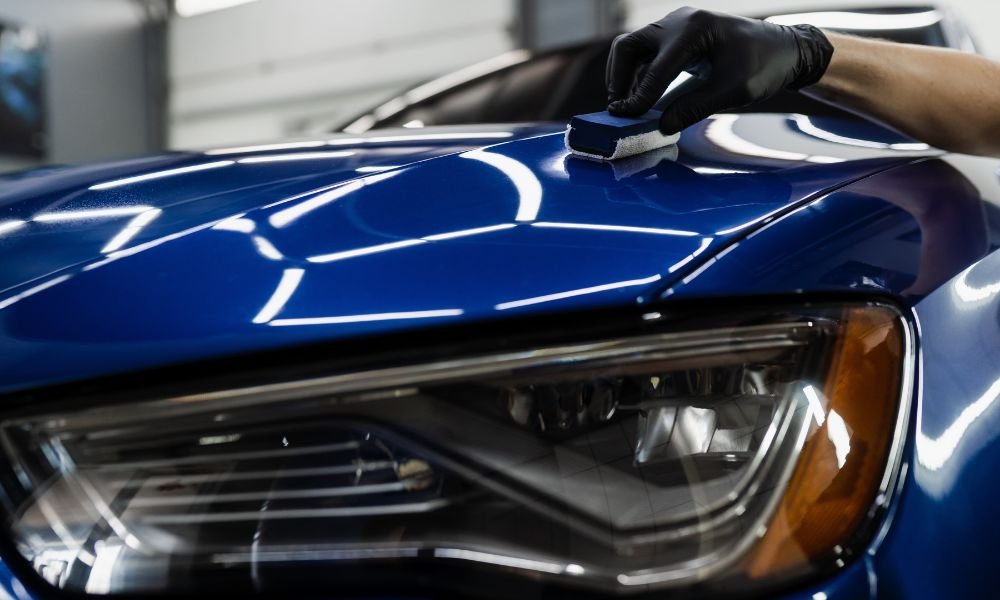The Benefits of Choosing Moro Auto Spa Ceramic Coating for Your Car
Unlock Superior Vehicle Security With Ceramic Finishing
Ceramic coating has actually arised as a sophisticated remedy for automobile defense, using a durable layer that safeguards against environmental damage. This ingenious liquid polymer not just improves the long life of your auto's paint but also gives a sleek, high-gloss finish that elevates its visual appeal. Recognizing the details of just how ceramic layer jobs and its myriad advantages is vital for any kind of automobile owner looking for to maintain their investment. However, the application procedure may present obstacles that warrant mindful consideration. What aspects should one take into consideration before continuing?

What Is Ceramic Finish?
Ceramic coating is a specific safety layer put on a lorry's exterior, made to enhance its resilience and appearance. This sophisticated modern technology contains a fluid polymer, which chemically bonds with the manufacturing facility paint of the car, developing a durable guard versus different ecological impurities. Unlike typical wax or sealers, which offer only temporary security, ceramic coverings provide lasting impacts that can stand up to the roughness of daily exposure to elements such as UV rays, road crud, and chemical pollutants.
The application procedure entails detailed surface preparation, consisting of cleaning, decontaminating, and polishing the car to make certain ideal attachment. When applied, the ceramic finish forms a hydrophobic surface area that repels water, making it simpler to clean and maintain the lorry's aesthetic charm. Additionally, the finish offers a high level of gloss, boosting the car's luster and overall aesthetic impact.
It is vital to keep in mind that while ceramic layers supply significant defense, they are not a replacement for regular maintenance and treatment. Understanding the nature of ceramic finishes is critical for automobile proprietors looking for to protect their investment and preserve its immaculate condition gradually.
Trick Benefits of Ceramic Layer
One of the most considerable advantages of applying a ceramic coating to a vehicle is the boosted security it anticipates different environmental dangers. This innovative safety layer works as a shield against UV rays, which can trigger paint fading and oxidation over time. Additionally, it successfully repels water, dirt, and gunk, making it much easier to maintain the car's look with minimal cleaning.
Ceramic coverings also offer exceptional resistance to chemical discolorations from compounds such as bird droppings, tree sap, and roadway salt, which can compromise a lorry's coating. This resilience extends the life-span of the cars and truck's paint, protecting its aesthetic allure and boosting resale worth.
Ceramic coverings supply a high-gloss coating that enhances the total aesthetic allure of the vehicle, guaranteeing it looks its finest for years to come. In recap, ceramic coatings deliver a comprehensive suite of advantages that considerably raise cars and truck defense and upkeep.
Exactly How Ceramic Covering Functions
The protective capabilities of ceramic finishings stem from their special chemical structure. Mainly composed of silicon dioxide (SiO2), these layers develop a covalent bond with the lorry's surface area, creating a incredibly long lasting and hydrophobic layer. This bonding process is important as it makes it possible for the covering to hold up against ecological impurities, UV rays, and harsh climate condition that can cause paint deterioration in time.

Furthermore, ceramic coatings use exceptional resistance to chemicals, including acids and alkaline materials, which better safeguards the automobile's coating description from engraving and damages. Consequently, ceramic coatings not just improve the visual charm of the vehicle yet also give long-lasting defense that can extend the life of the vehicle's exterior.
Application Process Explained
Accomplishing a remarkable surface calls for precise interest throughout the application of ceramic finishings. The procedure starts with a comprehensive clean and decontamination of the vehicle's surface area to remove dirt, grime, and previous wax or sealant deposits. This action is essential, as any kind of impurities can endanger the bonding of the ceramic finish.
Once the surface area is clean, it goes through a detailed evaluation for blemishes such as scratches or swirl marks. These imperfections must be remedied with polishing to make certain a smooth surface, enhancing the last appearance. After brightening, the surface area should be wiped down with an alcohol-based service to get rid of any kind of remaining deposits or oils.
The application of the ceramic finishing itself requires precision - Moro Auto Spa ceramic coating. Using a foam applicator, the finish is used in small sections, ensuring even coverage. It is vital to comply with the supplier's advised healing times, as this allows the coating to bond efficiently with the paint
When applied, the covering begins to cure and set, forming a durable safety layer. This procedure can take a number of hours, depending upon environmental conditions, however perseverance is key to attaining optimal outcomes and long-lasting protection.
Preserving Your Ceramic Finishing
Appropriate upkeep is crucial for protecting the integrity and efficiency of your ceramic layer. To guarantee its durability, routine washing is vital. Utilize a pH-neutral automobile shampoo and microfiber clean gloves to prevent scraping the surface area. Prevent automatic auto washes that may make use of unpleasant materials or harsh chemicals.

Check the coating consistently for indicators of wear or damages. A professional reapplication or covering with a ceramic booster may be needed. if you observe reduced hydrophobicity or fading.
Last but not least, prevent car parking under trees or in direct sunshine for prolonged durations, as these can contribute to ecological wear. By a fantastic read following these upkeep standards, you can maximize the advantages of your ceramic layer, guaranteeing your lorry stays safeguarded and cosmetically pleasing for several years to find. Proper care not just improves appearance yet likewise safeguards your investment in vehicle defense.
Conclusion
Ceramic coating stands for a considerable advancement in lorry protection, providing a robust remedy against environmental threats. Appropriate application and maintenance of ceramic finish are vital to maximize its advantages.
Ceramic finish has actually arised as a sophisticated remedy for vehicle security, using a durable layer that safeguards versus ecological damages. When applied, the ceramic layer develops a hydrophobic surface that fends off water, making it easier to keep the car and clean's aesthetic appeal.One of the most considerable benefits of applying a ceramic finishing to a vehicle is the improved defense it offers against different environmental threats.When applied, ceramic coatings permeate the microscopic pores of the automobile's paint, successfully sealing them and stopping water, dirt, and grime places from adhering to the surface area.Ceramic finish represents a significant innovation in car security, using a robust solution against ecological risks.